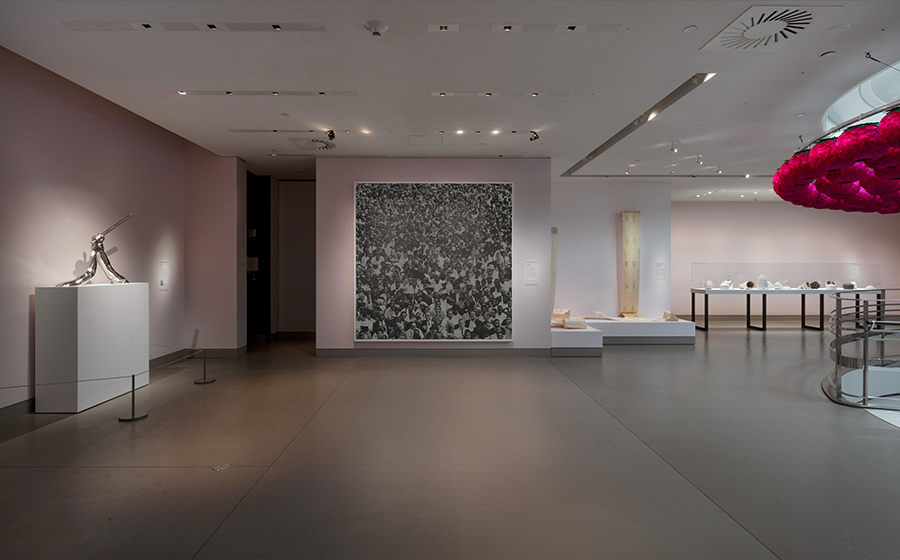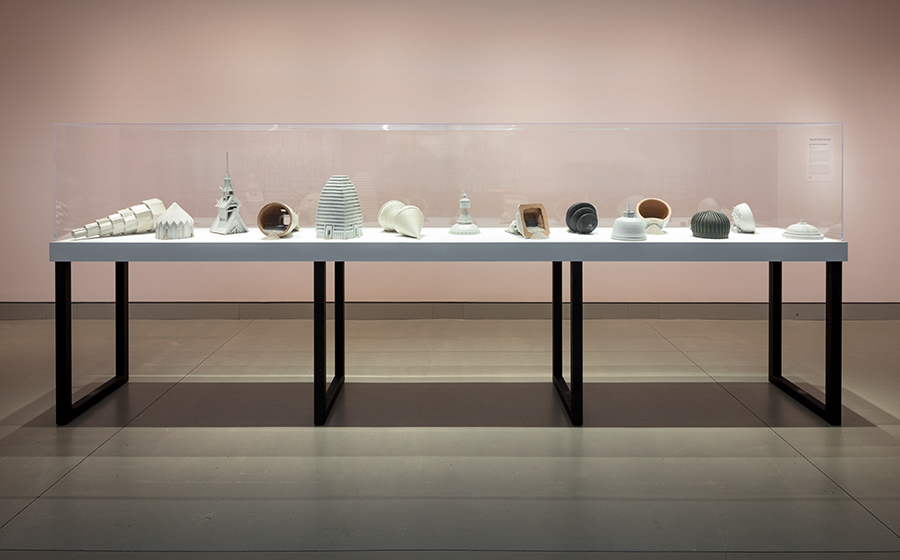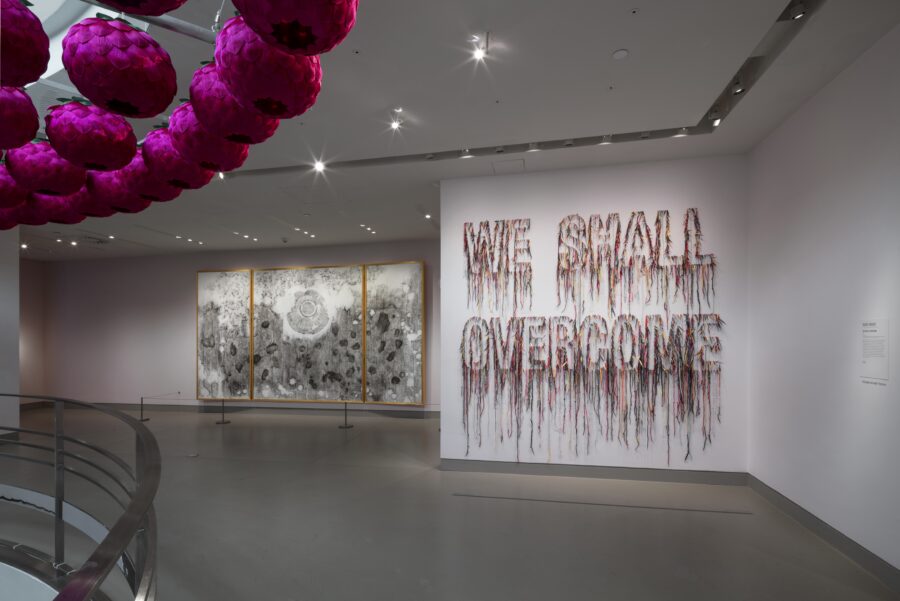
Lida Abdul (b. 1973, Kabul, Afghanistan; lives and works in Kabul and Los Angeles); Clapping With Stones (still); 2005; 16 mm film transferred to DVD; 5 min.; image courtesy of the artist and Giorgio Persano Gallery.

Lida Abdul (b. 1973, Kabul, Afghanistan; lives and works in Kabul and Los Angeles); Clapping With Stones (still); 2005; 16 mm film transferred to DVD; 5 min.; image courtesy of the artist and Giorgio Persano Gallery.
Identifying new pathways for deconstructing our thinking about power, the artists in the exhibition Clapping with Stones: Art and Acts of Resistance challenge repressive ideologies through poetic, non-conformist artistic gestures. Slicing through dominant histories and practices, the featured artists deflect the signs and symbols associated with normative power. By using alternative visual cultural methods that underscore the hidden, unseen, or previously unrecorded they collectively unravel the formation of biopower, a term borrowed from French poststructuralist theorist Michel Foucault. It refers to the postcolonial mechanisms by which modern Euro-American nation states exert political and economic sovereignty over local and remote people and places.
The exhibition and art respond to culture wars—the conflict between cultural workers and conservatives. In the 1980s and 1990s under the Republican presidencies of Ronald Reagan and George H. W. Bush, there was a crackdown on artistic freedom of expression. Cutbacks on public arts funding were perceived as a form of financial retribution for artists failing to comply with conservative norms and values. Culture wars have now reemerged under the stringent agendas propelled by some governments worldwide, which have resulted in the rollback of civil liberties and spurred a complex global domino effect.
Clapping with Stones responds to our changing, divided societies and presents alternative artistic proposals that are not necessarily concerned with creating a mythical iron curtain between opposing groups. Rather the intention is to create a visual cultural framework that weaves in other histories, disrupting homogeny, power, and position.
Operating as an allegorical connection between these ideas is Lida Abdul’s film Clapping with Stones (2005), from which the exhibition borrows its title. Shot at the foot of the now-destroyed sixth-century Buddhas of Bamiyan Valley in Central Afghanistan, this conceptual film features a group of men dressed in traditional black shalwar kameez. They are engaged in a reimagined pre-Islamic shamanistic mourning ritual of clapping two stones together.
The Buddhas were part of Afghanistan’s rich cultural history and an important tourist site before the Taliban, an Islamic fundamentalist group, destroyed them in 2001. Two motives prompted this barbaric act. First, the Buddhas were deemed to be sacrilegious and a form of idolatry. Second, their destruction was a form of protest against UN imposed sanctions. This reason reveals a larger historical discord, as Western factions were instrumental in the Taliban’s rise to power during the Soviet-Afghan war of 1979 to 1989. Abdul’s film thus questions the remnants of a proxy war that pitted Islam and communism against one another to mask Western interests, plunging Afghanistan into the theater of war for four decades with no immediate end in sight.

Nari Ward (b. 1963, St. Andrew, Jamaica; lives and works in New York); Breathing Room; 2019; used American history textbooks, stencil ink, French Country grandfather clock with African Fang figure, copper sheet with patina, copper nails, nesting table, narrow chair, lion’s foot oval table, dome surveillance mirror, area rug; courtesy of the artist and Lehmann Maupin Gallery, New York, Hong Kong, and Seoul; installation photograph by David De Armas.
In comparison Nari Ward’s installation Breathing Room (2019) focuses on the transatlantic slave trade and highlights the lingering issues of race, identity, power, and migration inside the United States. Ward sourced secondhand furniture from the turn of the twentieth century to create a period room of freestanding furniture and used American history books piled on top of a chair and tables. He treated the furniture with a black ink typically used to mark shipping containers, a reference to migration.
Ward adorned the books and the clock with a West African cosmogram, a diamond-shaped Kongolese symbol, which he created by drilling holes and adding conjoined circles formed by copper nails. The artist calls them breathing holes, referencing an escape tactic adopted by nineteenth-century enslaved African Americans in Savannah, Georgia. They hid under the floorboards of the First African Baptist Church, which were punctured with similar patterned holes to allow them air to breathe.
Hovering above the installation is a surveillance mirror that functions as a symbol of double consciousness. The acclaimed African American author W. E. B. Du Bois introduced the term double consciousness in his seminal book of sociological essays, The Souls of Black Folk (1903). Du Bois outlined the African American experience of possessing more than one social identity, consisting of one self and a second self as seen through the eyes of the so-called dominant other. Ward’s installation unites cultural memory and the complicated history of slavery in America, the remnants of which still reverberate in today’s society.
Clapping with Stones also explores the recording of visual cultural knowledge that is ordinarily unrecorded or latent. The artists use conceptual and poetic strategies, such as metaphor and simile, to unveil complex histories and subterranean truths concerning the complicated relationship between histories and state apparatuses.

Pallavi Paul (b. 1986, New Delhi, India; lives and works in New Delhi); Burn the Diaries; 2014–2019; 110-foot digital print on silk; courtesy of the artist; installation photograph by David De Armas.
One such example is Pallavi Paul’s 110-foot silk scroll Burn the Diaries (2014–19). It is inspired by the personnel file of Indian-born former Special Operations Executive (SOE) agent Noor Inayat Khan, who served as a spy for the British government during World War II in Nazi-occupied France. She vanished and her body was never recovered, leaving many unanswered questions. Her official file contained flaws and recounted many versions of her suspicious disappearance and death.
Paul takes and subverts Khan’s story as part of a larger inquiry into the role of official archives in producing transparent evidence and facts. Upon the monumental 110-foot silk scroll Paul printed inscriptions in Morse Code of different accounts of Khan’s death. The artist originally planned for people to read the scroll as a public performance, raising important questions about the mapping of underground truths.

Hank Willis Thomas (b. 1976, Plainfield, NJ; lives and works in New York, NY); The March; 2017; UV print on retroreflective vinyl, mounted on Dibond; courtesy of the artist and Jack Shainman Gallery, New York; installation photograph by David De Armas.
Similarly, Hank Willis Thomas explores latency and its thorny relationship to history with the retroreflective UV print The March (2017). The title is inspired by one of the famous Civil Rights marches in 1965 led by the minister and activist Martin Luther King Jr. The image depicts a mass of peaceful protesters marching to demand equal voting rights. The piece is activated by the flash of a smartphone or iPad camera when taking a picture. The light fully illuminates the work and amplifies the many ways of reading and processing histories of social activism, as well as providing agency to marginal voices and truths that have been contorted or sidelined.

Shahpour Pouyan (b. 1979, Isfahan, Iran; lives and works in New York); My Place Is the Placeless; 2016–2019; 15 stoneware glazed ceramics and ash; courtesy of the artist; installation photograph by David De Armas.
Shahpour Pouyan also responds to the theme of truth and meaning with his response to the rise in rhetoric surrounding nationalism and racial purity. Pouyan’s My Place Is the Placeless (2016–2019) features fifteen stoneware glazed ceramic domes, some of which contain ash, that represent the indigenous architecture of the places of his ethnic origins.
To research this piece, the artist took a DNA test in 2014 that revealed his ties to Scandinavia, Central and South Asia, and the Middle East. Pouyan received updates from the test in 2019, revealing discrepancies with the initial results, including a lack of ancestral ties to the Middle East. The artist documented these results with fifteen new ceramic domes representing places such as Manchuria, Korea, and the Caucasus Mountains.
With its title borrowed from the opening line of a poem by the renowned thirteenth-century Persian poet Rumi, My Place Is the Placeless comments on belonging and origins. It reveals the paradoxical nature of returning to the idea of origins, whereby the language of art becomes a useful tool in questioning systems of power and truth.

Kimsooja (b. 1957, Daegu, South Korea; lives and works in New York and Seoul); Lotus: Zone of Zero; 2019; site-specific installation of 272 lotus lanterns, Tibetan, Gregorian, and Islamic chants; courtesy of Kimsooja Studio; installation photograph by David De Armas.
Kimsooja also explores the need to mend and return to origins. Her monumental site-specific installation Lotus: Zone of Zero (2019) comprises 272 pink lotus flower lanterns accompanied by an ambient soundtrack fusing Tibetan, Gregorian, and Islamic chants. Suspended from the Rubin Museum’s oculus, the work serves as the physical nucleus of Clapping with Stones and is central to the exhibition’s design.
Visitors must walk around Lotus: Zone of Zero to access the other artworks on view, and the installation invites them to reflect on a moment of harmony and coexistence, where time and space are intentionally arrested. Kimsooja’s work can be viewed as a poetic call for peace and unity during a period of social and political turbulence.
Throughout the exhibition the idea that power begins within us and flows between us is echoed, connecting different contemporary art practices that imagine other possibilities for enlightening human consciousness. Through the cross circulation of meaning and knowledge, Clapping with Stones aims to present a continuous dialogue between the self and other in pursuit of collective power and interconnectedness.
The exhibition Clapping with Stones: Art and Acts of Resistance was on view at the Rubin Museum from August 16, 2019, to January 6, 2020.

Sara Raza is a writer and curator specializing in contemporary global arts. In 2016, she won the ArtTable New Leadership Award for Women. She was the Guggenheim UBS MAP curator for the Middle East and North Africa, and she curated But a Storm Is Blowing from Paradise at the Solomon R. Guggenheim Museum (2016), which travelled to the Galleria d’Arte Moderna, Milan (2018).

Rubin Museum
150 W. 17th St., NYC
Get the latest news and stories from the Rubin, plus occasional information on how to support our work.